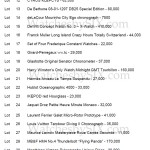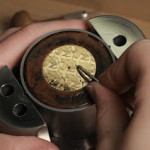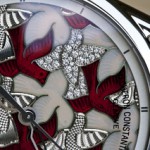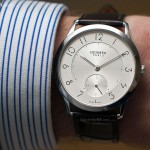In-Depth: Why the Position of a Watch Influences Accuracy
Poising, amplitude, and overcoils.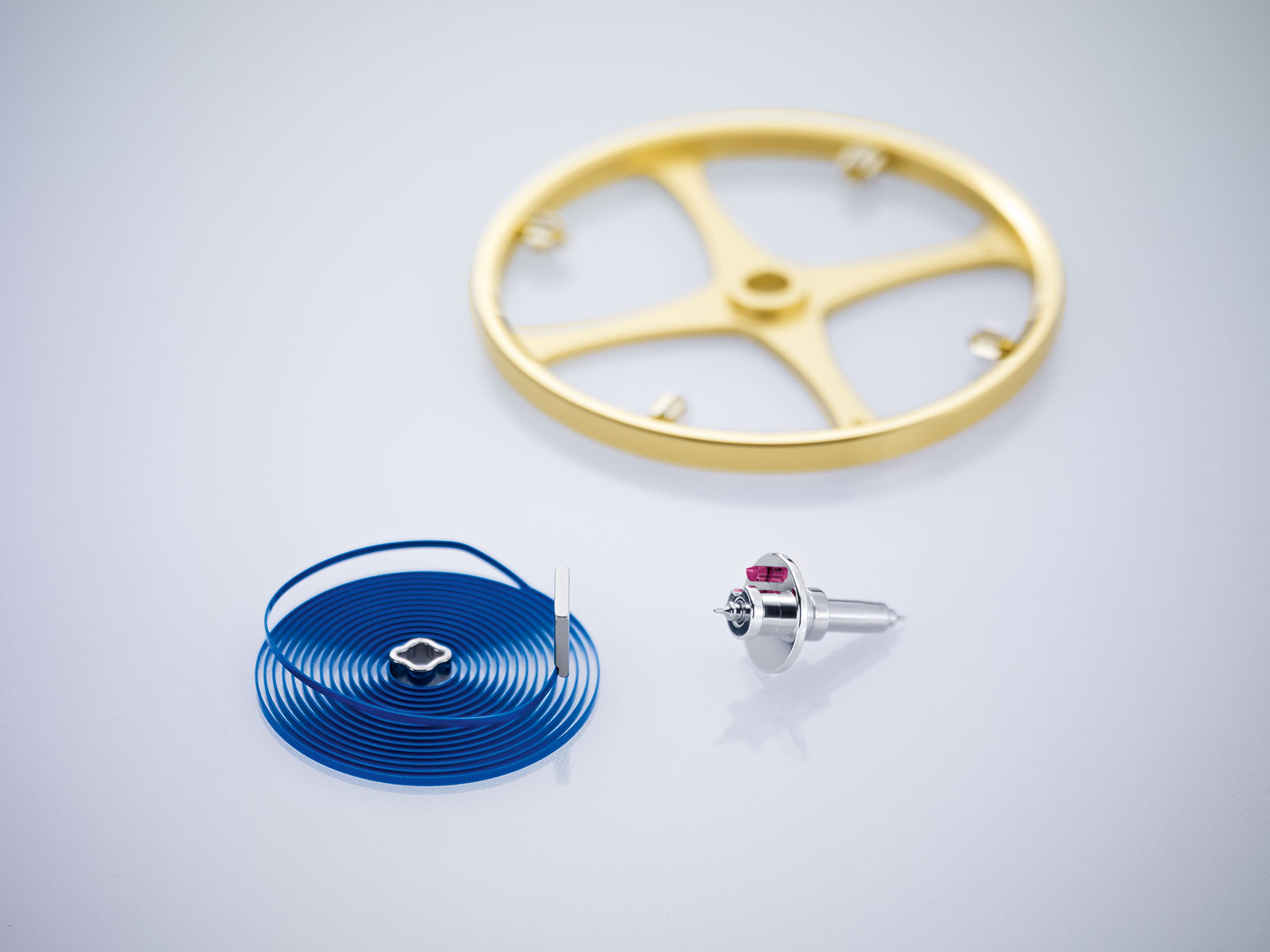
A mechanical watch movement is a tiny-but-complex system made up of components in equilibrium, operating flawlessly. But because the those components are delicate – especially the parts that make up the escapement – its operation can be influenced by external factors, including shock, moisture, and more commonly, the position of the watch, whether on the wrist or off.
The position of a watch determines how gravity affects the moving parts of the movement. In other words, the timekeeping of a watch can vary according to whether it is laid on its back or on its side. That resulting variation is known as positional error, and it is largely because of gravity’s effect on the balance wheel – the oscillator in the regulating organ of the movement.
Beyond the position of a watch, positional error is also shaped by factors like the amplitude of the balance wheel, the type of hairspring, and the poise of the balance. All are inextricably linked and must be adjusted just right – properly regulated in watchmaking parlance – in order for a watch to have minimal positional error and thus keep good time.
[Editor’s note: In this article we’ll just deal with movements constructed traditionally with conventional materials, leaving out silicon-equipped movements, which are still relatively niche.]
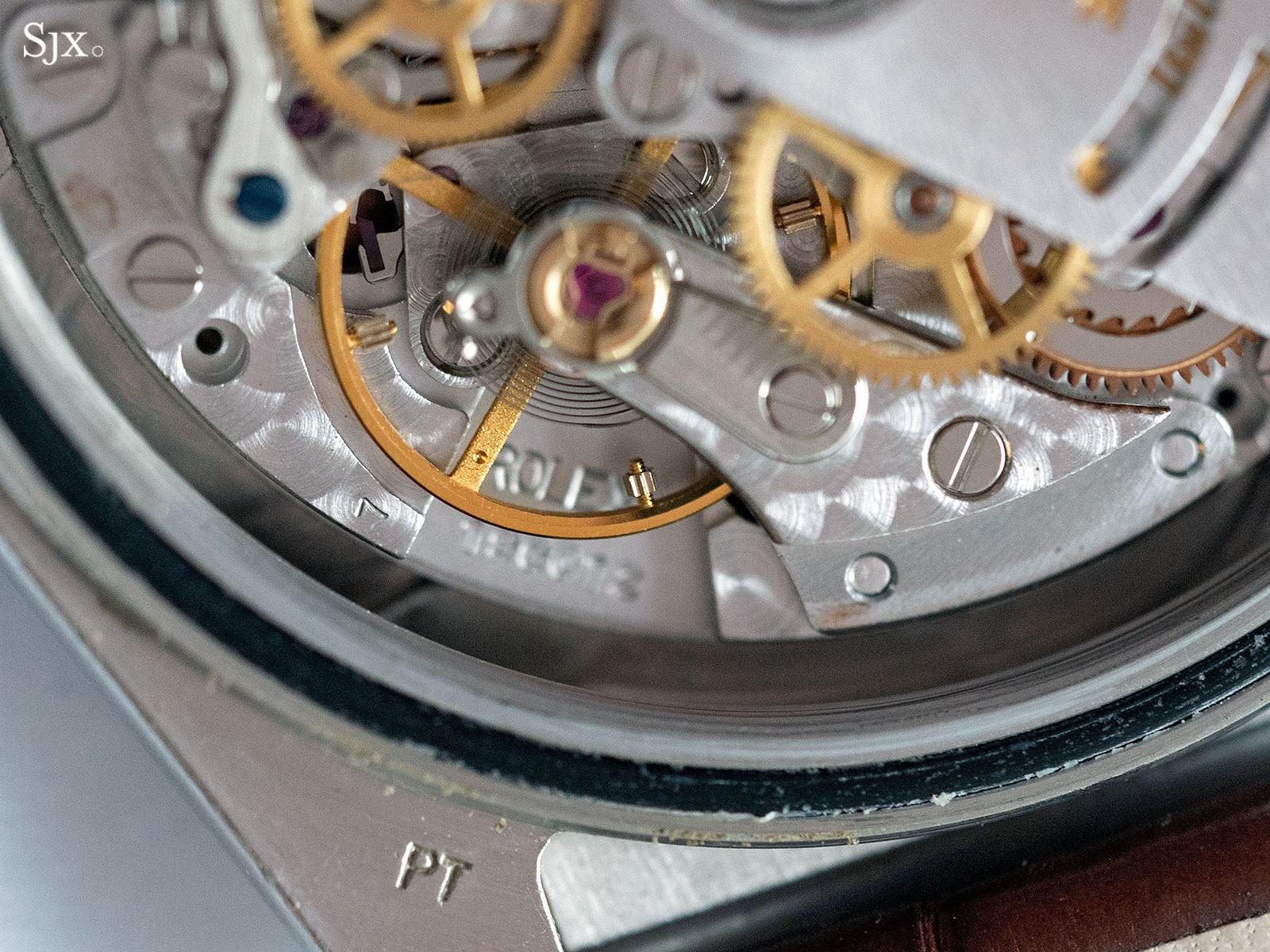
The Microstella adjustable-mass balance of the Rolex cal. 4030, which is based on the Zenith El Primero
A matter of position
The position of a watch significantly affects its accuracy; specifically, it is the consequence of gravity’s effect on the balance wheel – pulling it downwards regardless of the position of the watch.
The balance wheel of a watch can be thought of as a bicycle wheel lying flat on the ground that oscillates back and forth. It has a pivot (or balance staff) through its centre, which is supported by jewelled bearings on each end. Over each jewelled bearing is a cap jewel, or end stone, that serves to limit the axial movement of the pivots as well as to hold lubricants in place. And the end stone is in turn secured by a tiny spring, often produced by Swiss specialists Kif or Incabloc, that functions a shock absorber.

A cross section of a showing a balance assembly with the Incabloc “lyre-spring” over the cap jewel, with jewelled bearing containing the balance pivot at the bottom. Diagram – Incabloc
A watch is usually running at peak performance when it is face up or face down, or “dial up” or “dial down” in watchmaking parlance. This means the movement is horizontal, or parallel to the ground, and has the least friction, with the main contact being the tip of the lower pinion that’s supported by the bottom cap jewel – akin to a spinning top on a table.
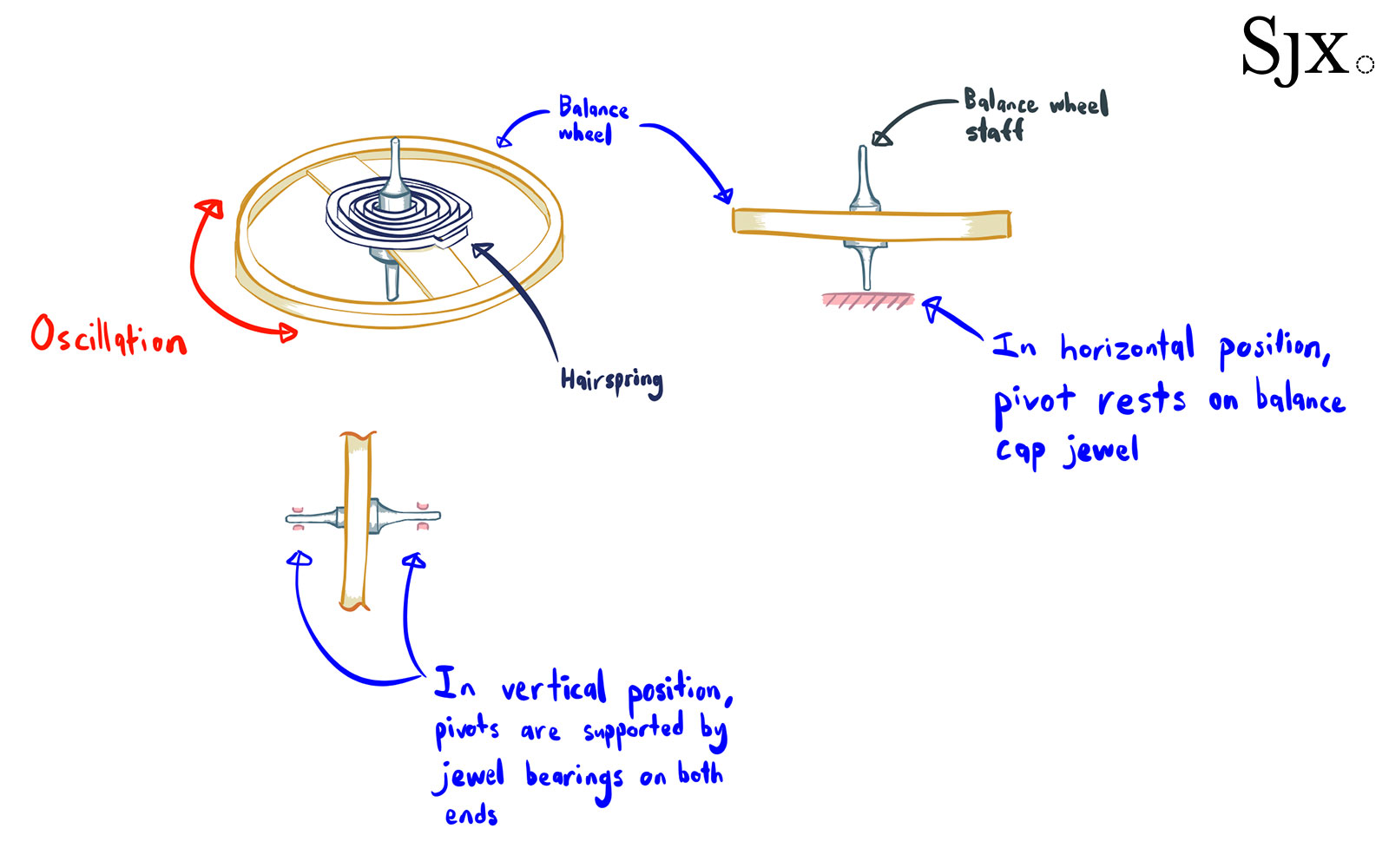
Diagram – the author
Thus, a practical tip for watch owners: when a mechanical watch is removed for the night, it is best to place it dial up or dial down to keep accurate time. Meanwhile, when a watch is placed in long-term storage, the position doesn’t matter as the watch will eventually stop running once the mainspring runs down.
When the watch on a bracelet or with a folding clasp is laid on its side in a vertical position, this is called “crown up” or “crown down” in watchmaking parlance. In this situation, the surface contact area of both pivots of the balance wheel is much greater since both pivots turning against the wall of the bearings. It’s akin to a pen being laid flat on a table, instead of standing on its tip, as is the case when a watch is face up or down.
Consequently, friction on the pivots will always be higher when the watch is placed on its side. However, this can be kept to a minimum by ensuring the watch is clean, well-oiled and with the pivots in good condition.
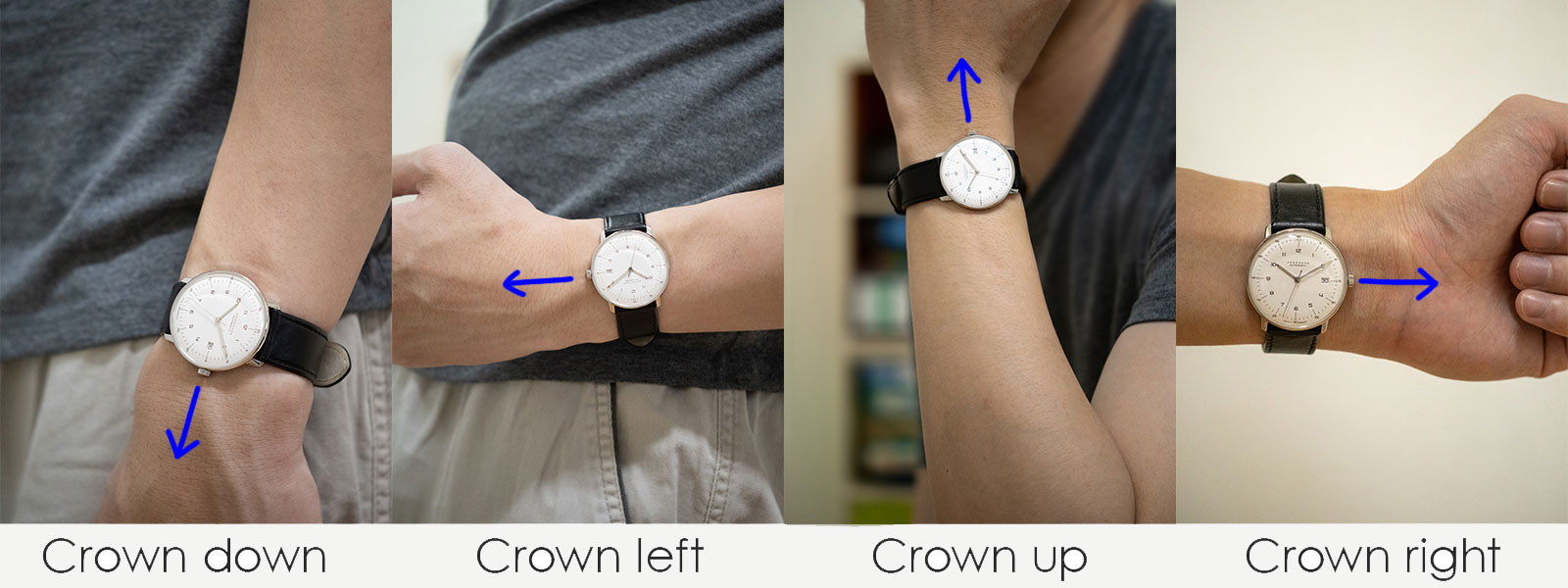
The four vertical positions of a watch will result in timekeeping variation. This is due to the hairspring being attached to a fixed point on the balance wheel, and is affected by gravity downwards. Thus, it is a balancing act for a watchmaker to regulate a watch as it simply impossible to obtain theoretically perfect timekeeping in all positions – priority will be given to the most common positions first.
As there are six positions – dial up and down, and the four vertical orientations – well-adjusted watches will be advertised as adjusted to all six positions, with some adjusted to five positions as a nearly-as-good compromise. The most important are the dial up and down positions, as these should demonstrate good and identical timekeeping since the pivots are not resting on the inner walls of the bearing jewels, and are indicative of a healthy gear train.
Then, crown down is considered which represents someone’s arm hanging down while standing. This is followed by crown left which happens when resting your arm horizontally on a desk. Lastly, crown up and crown right are least considered as they are uncommon positions, such as lifting your arm straight up or behind your head.
It is important to note that the above is applicable to the majority demographic which is right-handed – a left-handed person will experience all the vertical positions in reverse. This is evident considering that wearing a watch on the right wrist results in the crown pointed upwards the forearm, instead of downward towards the left hand.
With all this discussion on the vertical position, why is friction of the balance wheel pivots an issue? While the prolonged effects would be eventual wear of the thin pivots, a more immediately apparent issue arises – a drop in amplitude.
Various watchmakers have created complications to combat positional error, including one that made its debut just last year, the F.P. Journe Tourbillon Souverain Vertical. It has the balance wheel perpendicular to the dial, so that the balance is always vertical whether the watch is crown-down or face-up, which are the most common positions. And because the balance is within a tourbillon, gravitational errors are averaged out.
A matter of degree
Beyond the position of the watch, its timekeeping is also affected by internal factors. A watch requires energy to run, which is produced the mainspring and transmitted through the going train to the balance wheel, causing it to oscillate.
The magnitude of the back and forth swings of the balance wheel, expressed in degrees, is known as amplitude. In general, more power means greater amplitude; greater amplitude means greater inertia and more stable timekeeping. A healthy movement usually runs with an amplitude of between 270° and 310° when fully wound.
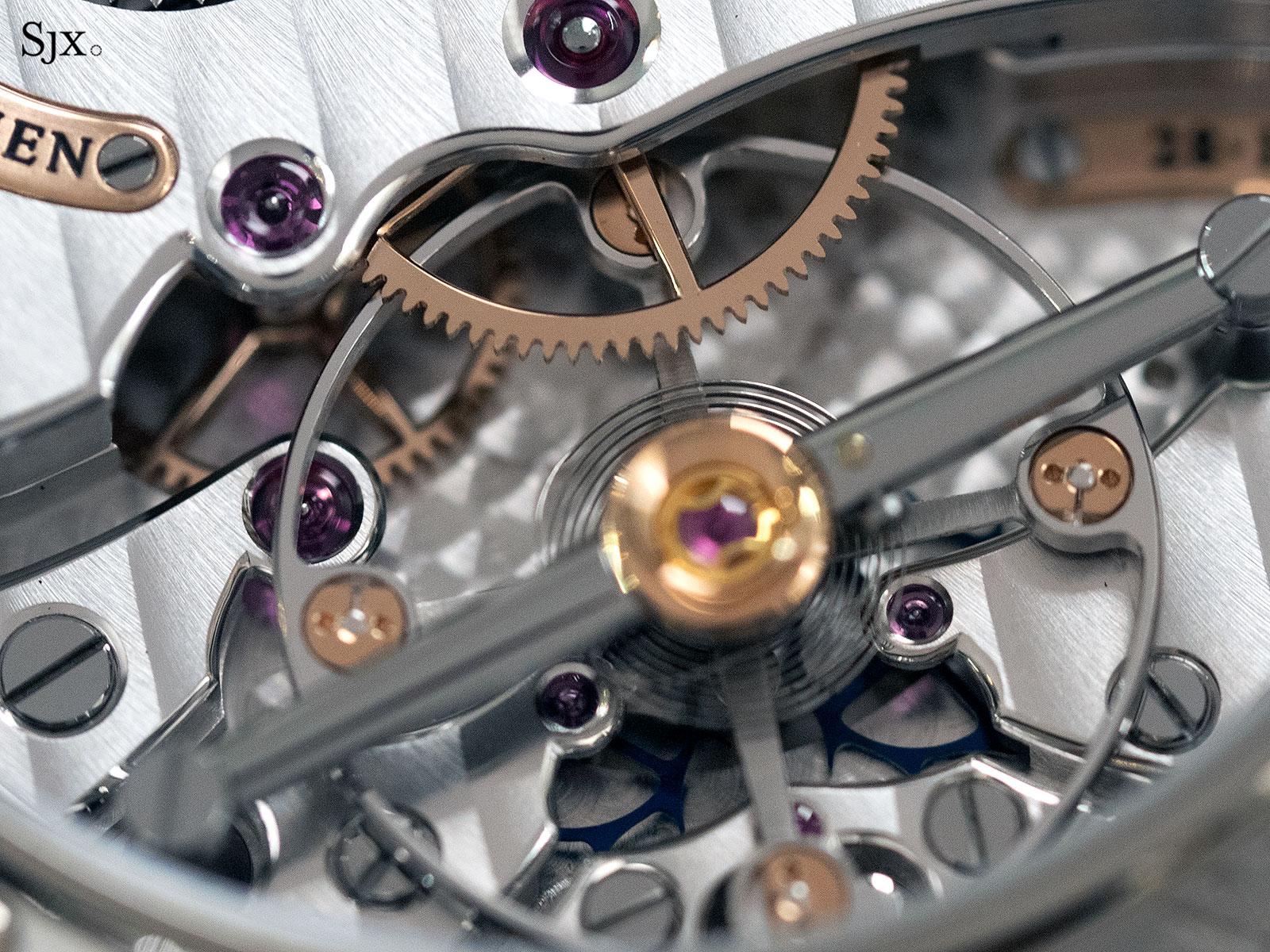
The extra-large balance wheel in the Voutilainen Vingt-8
Low amplitude watches will be more susceptible to stopping and erratic timekeeping. This is because it’s easier to transfer external unwanted forces, such as shock, which interrupts the low momentum of the balance wheel.
However, having an overly high amplitude is not good either. This occasionally happens when servicing a vintage watch with the use of better, modern lubricants and if the mainspring is replaced with an overly strong one. The result is overbanking or “knocking”, whereby the balance wheel wants to swing a full revolution but collides with the outer edge of the pallet fork – potentially damaging the roller jewel.
Well poised
Another factor that determines positional error is the poise of a balance. Poising refers to the process of ensuring weight is evenly distributed across the rim of the balance wheel. Without poising, a balance wheel will have heavy spots along its rim, which will be influenced by gravity’s pull especially in the vertical orientation.
Imagine riding a bicycle with a heavy weight attached on one part of the wheel’s rim – the shifting weight as the wheel rolls result in varying effort for the cyclist while pedalling. For the same reason, car tyres also requiring balancing, which is done by sticking or clipping tiny weights to the wheel rim. The same applies to the balance wheel of a watch, except that the balance oscillates back and forth rather than spinning in one direction.
Consequently, the amplitude of oscillation especially matters for an unpoised balance wheel in the vertical position. This is because different amplitude causes the heavy spot to travel different distances along the arc of oscillation. Depending on orientation, gravity will pull the heavy spot downwards either in favour or against the direction of oscillation and therefore, resulting in the watch running fast or slow.
Thus, regulating a watch with an unpoised balance wheel is futile – even if the watch is perfectly regulated at its healthy amplitude of between 270° and 310°, its timing will drift as its amplitude inevitably drops as the mainspring winds down. Not to mention erratically, depending of the orientation of the watch with respect to gravity.
Therefore, for a watch to have the lowest positional error possible, the balance wheel must be perfectly poised, or equally weighted all along its rim. This is achieved by removing material from the heavier side of the rim via drilling tiny holes, or by changing the weights on screwed balances usually found on traditional watches.
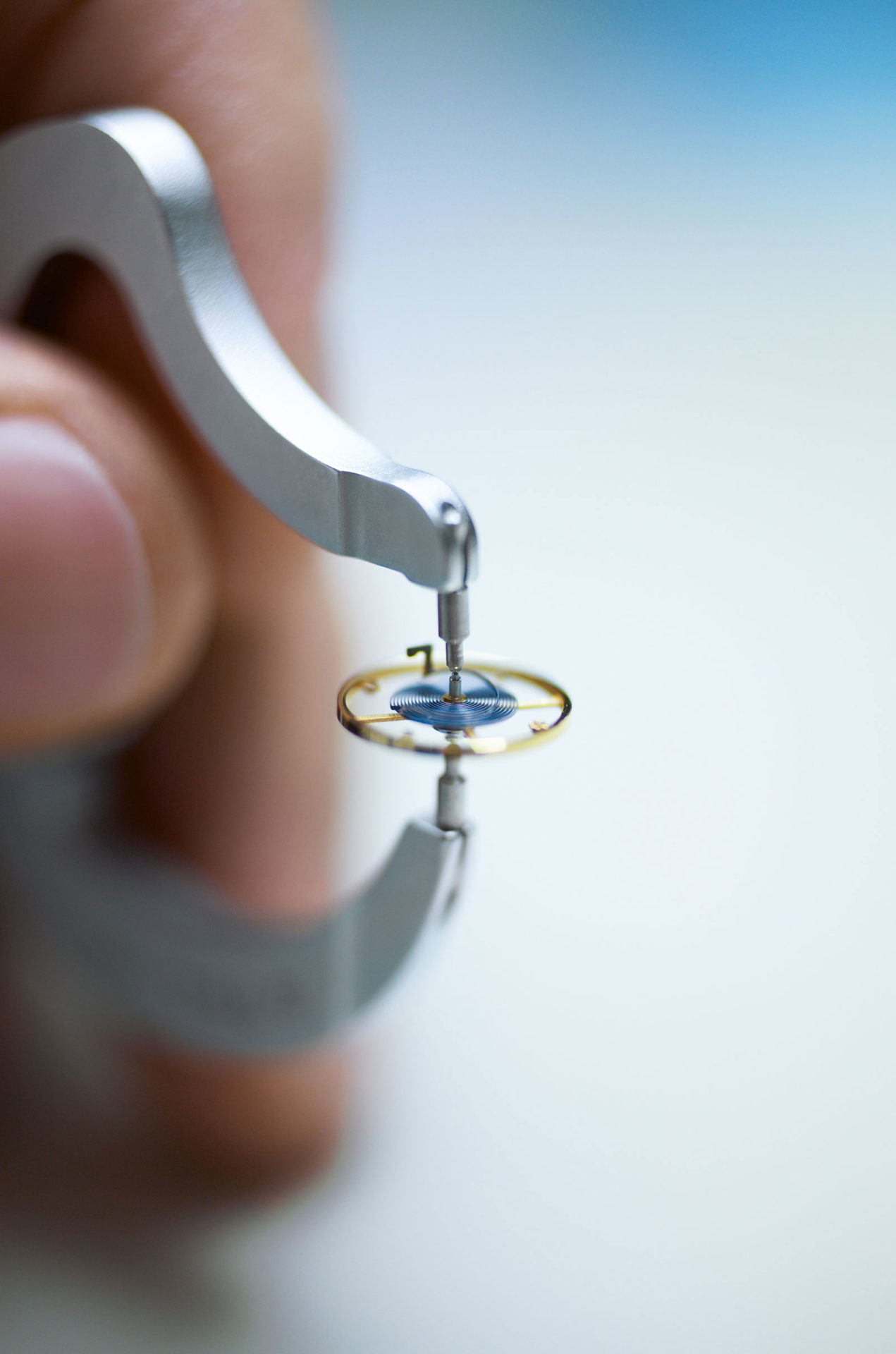
Examining balance spring for any eccentricities after poising. Photo – Rolex
When a movement is being assembled at the factory, new balance wheels will be automatically poised via modern computer-aided machines. The poising is done via removal of material with lasers, which etches a tiny hole or groove into the underside of the balance wheel.
However, when a watch is returned for repair and requires the balance wheel to be disassembled, the poising will be completed manually by a watchmaker. This is because reassembly of the balance wheel will override any previous poising attempts, due to unavoidable minute errors when fitting the components back together.
Wear and tear
That could potentially happen due to worn parts that requires replacement, which is another source of rate variation and positional errors to the balance wheel, especially over the long term.
For instance, with wear and tear over time a balance staff may need changing. This happens when the balance pivots become worn down and thinner over time, robbing the watch of healthy amplitude via friction. The greater the friction generated by the worn pivots, the greater the loss in amplitude which is especially noticeable in the vertical position.
And in severe cases of wear, replacing worn parts is a pressing issue in order to avoid further wear and tear, as worn-out parts generate metal filings due to abrasion, which can migrate to other parts of the movement.
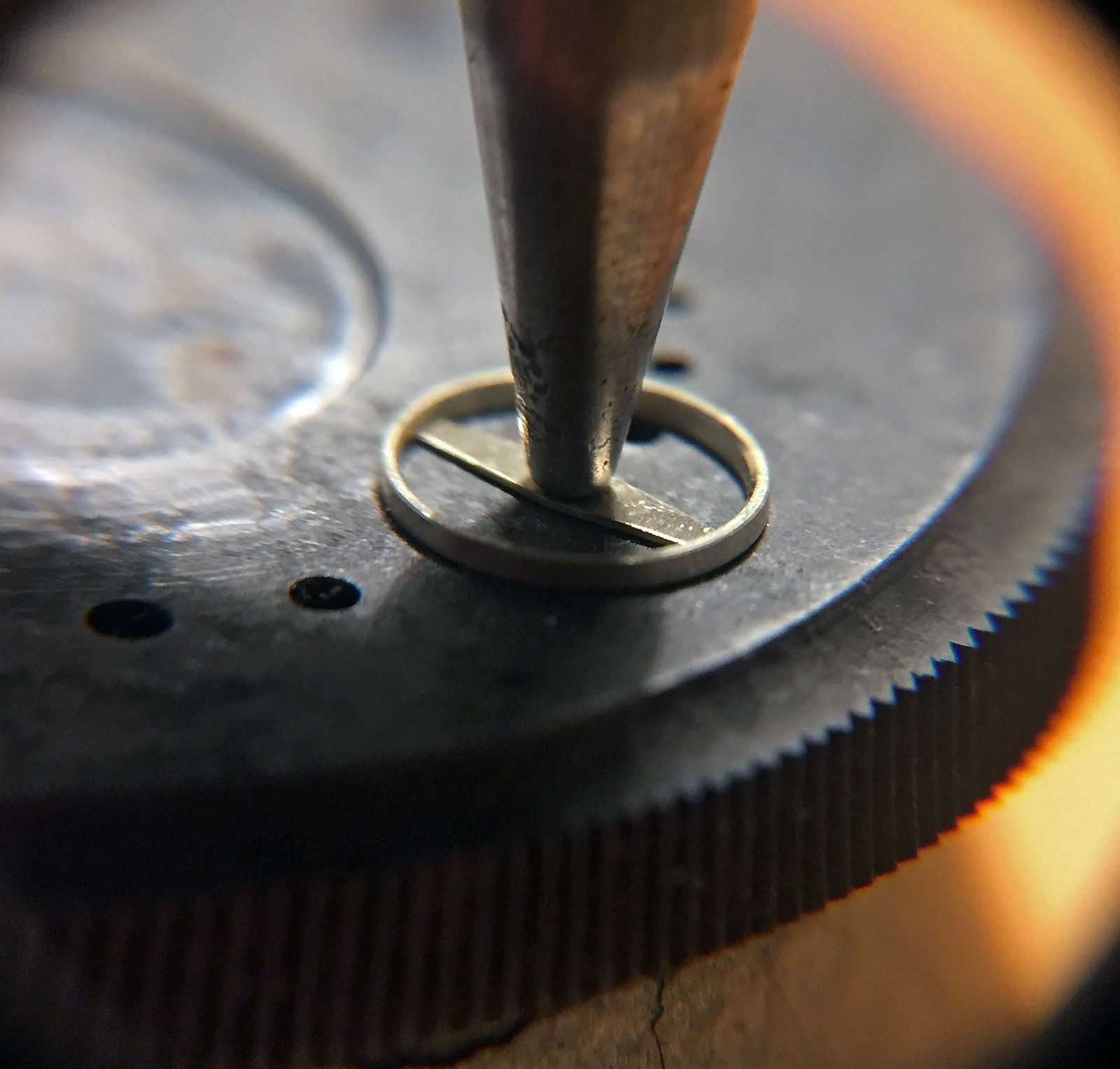
Riveting a new balance staff. Photo – Ashton Tracy
Replacing a worn balance staff often results in an instant increase in amplitude and greater accuracy. But as such replacements go, the entire balance assembly has to be poised again as discussed above.
Also, the pivots and ends of the balance staff should be kept as clean as possible since they contact the bearings – having one pivot dirtier than the other may result in positional errors between dial up and down for instance.
The hairspring
An inseparable companion of the balance wheel is the hairspring, which allows a controlled oscillation that defines the timekeeping. Ideally, the balance spring needs to expand and contract, or “breathe”, in a concentric manner. This means the spring maintains the same amount of space between its coils throughout its motion.
Balance springs generally come in two varieties – flat or with an overcoil. The latter comes in many forms, with the best known being the Breguet overcoil, named after French watchmaker Abraham-Louis Breguet (1747-1823), who invented it in 1795.
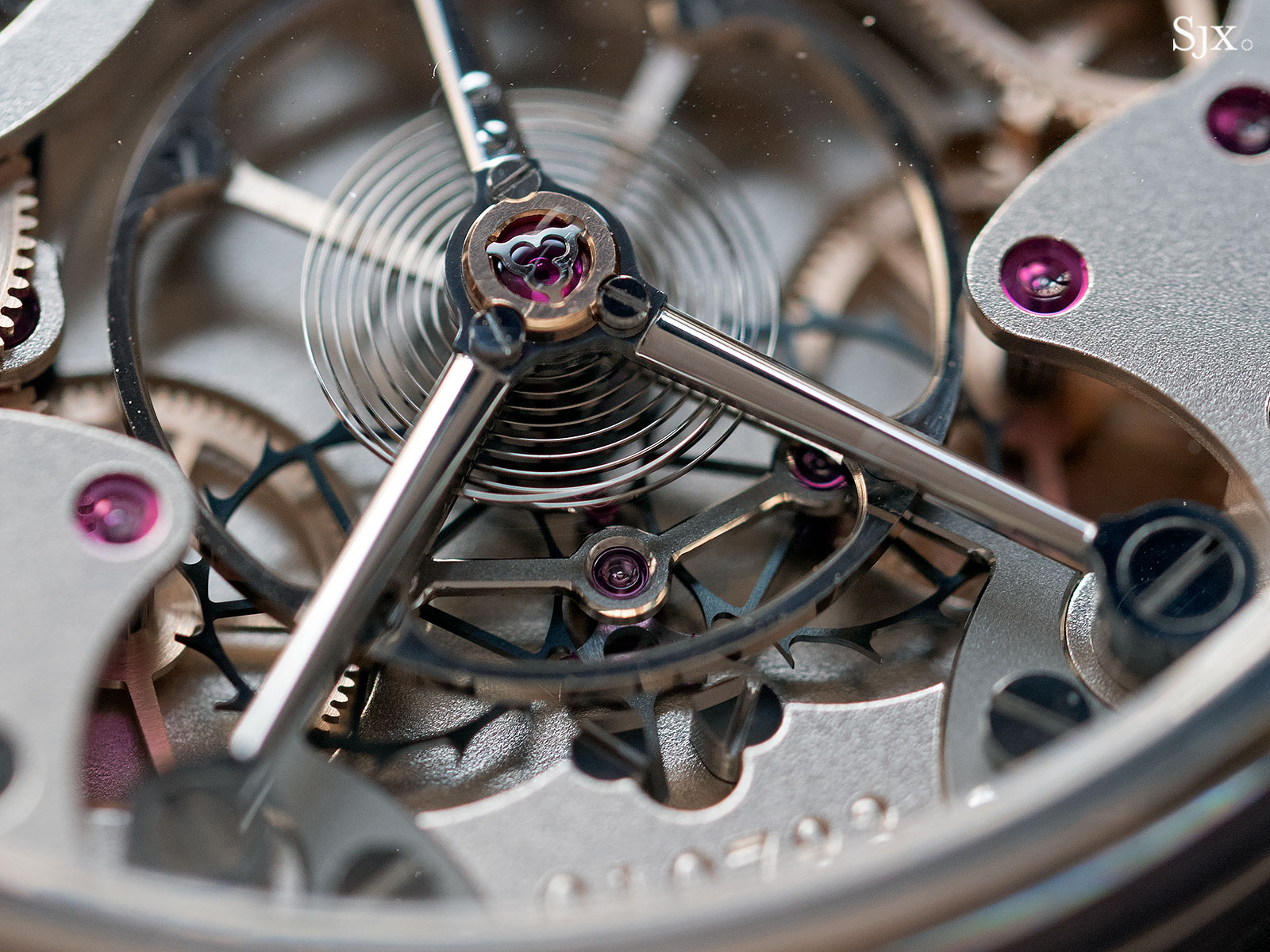
The overcoil hairspring in the Charles Frodsham Double Impulse Chronometer
A flat hairspring is exactly that – perfectly flat in profile. It’s outermost end is immobile and pinned to the balance cock of a watch, while the innermost end is fixed to the balance wheel that is free to oscillate. Geometrically however, a flat hairspring doesn’t “breathe” perfectly concentric – the oscillation causes the innermost end to turn and distorts the hairspring eccentrically, shifting the hairspring’s centre of gravity and varying the spring’s restoring force on the balance wheel.
This is undesirable as it results in the hairspring forces varying with amplitude, compromising isochronism – the property that the oscillation time is maintained regardless of amplitude. As discussed earlier, varying amplitude affects timekeeping depending on the watch’s orientation, as the mainspring barrel slowly uncoils and gradually supplies less power to the oscillating balance wheel, resulting in less amplitude overtime.
To mitigate this, some hairsprings are formed with an overcoil. Put simply, the outer curve of the hairspring is bent over the hairspring coil in a specific curve to ensure the breathing is as concentric as possible. This results in better isochronism as the breathing of the hairspring is centred throughout its oscillation.
However, overcoil hairsprings are more costly and time consuming to produce, since they typically have to be bent by hand. Furthermore, an overcoil requires extra height, resulting in a thicker movement, which is usually a space constraint especially with thin or automatic movements. This is why flat hairsprings are the industry norm, rendering overcoils a desirable feature especially on higher-end watches.
And it is worth noting that overcoil hairsprings are almost all made of metal alloys, as silicon is not malleable enough to be bent into an overcoil. A handful of specialists have managed to create silicon overcoils, either by joining two separate pieces of silicon, as Breguet has done, or by treating the silicon with a special process to allow it to be bent into shape, something pioneered by Master Dynamic in Hong Kong.
The Master Dynamic silicon hairspring with an overcoil. Photo – Master Dynamic
The concentricity of an overcoil can also be replicated with a double hairspring, which is only found in niche, high-end watches. It is made up of twin hairsprings stacked one on top of another in opposite directions, therefore the breathing of each hairspring compensates for each other.
Amongst the best known are the tourbillons of H. Moser & Cie. and Laurent Ferrier, both of which use double hairsprings made supplied by Moser’s sister company, Precision Engineering.
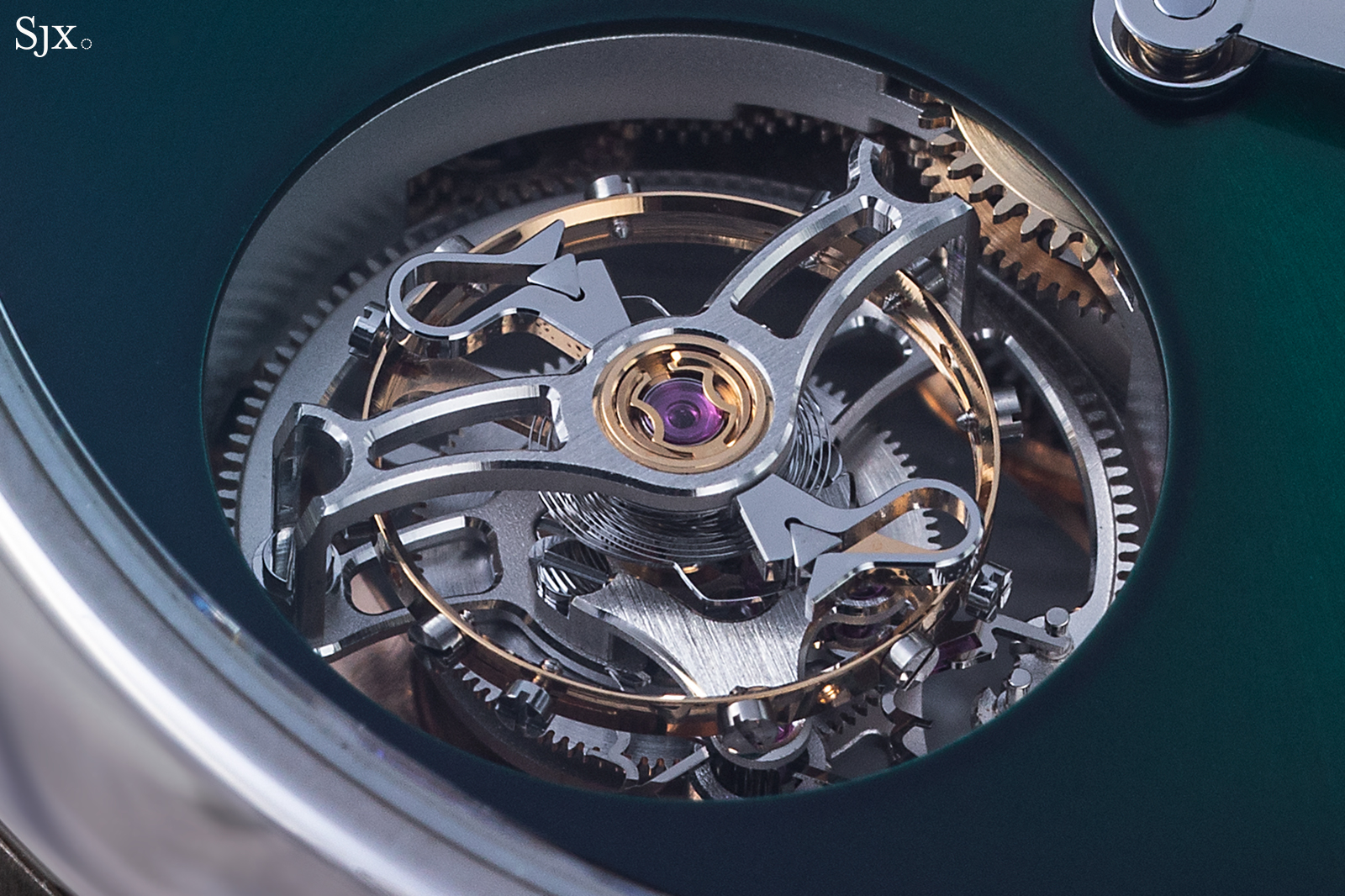
A closeup of the H. Moser & Cie Endeavour Tourbillon Concept equipped with a double hairspring within the tourbillon
Free and smooth balances
Even if the parts of a movement are perfectly fabricated and assembled, a watchmaker often still needs to perform manual adjustments to ensure the balance wheel beats at the correct rate. This is known as regulation.
Practically all mechanical watches are designed with a way to tweak the rate of the oscillator. The two most common methods of fine-tuning the rate are the hairspring regulator and the variable inertia balance. In theory, both methods of regulation should produce similar results if done correctly.
The traditional method is the regulator, a nearly universal piece of kit that can be found in the most affordable to the most expensive wristwatches. The regulator consists of two small pins that change the active length of the hairspring.
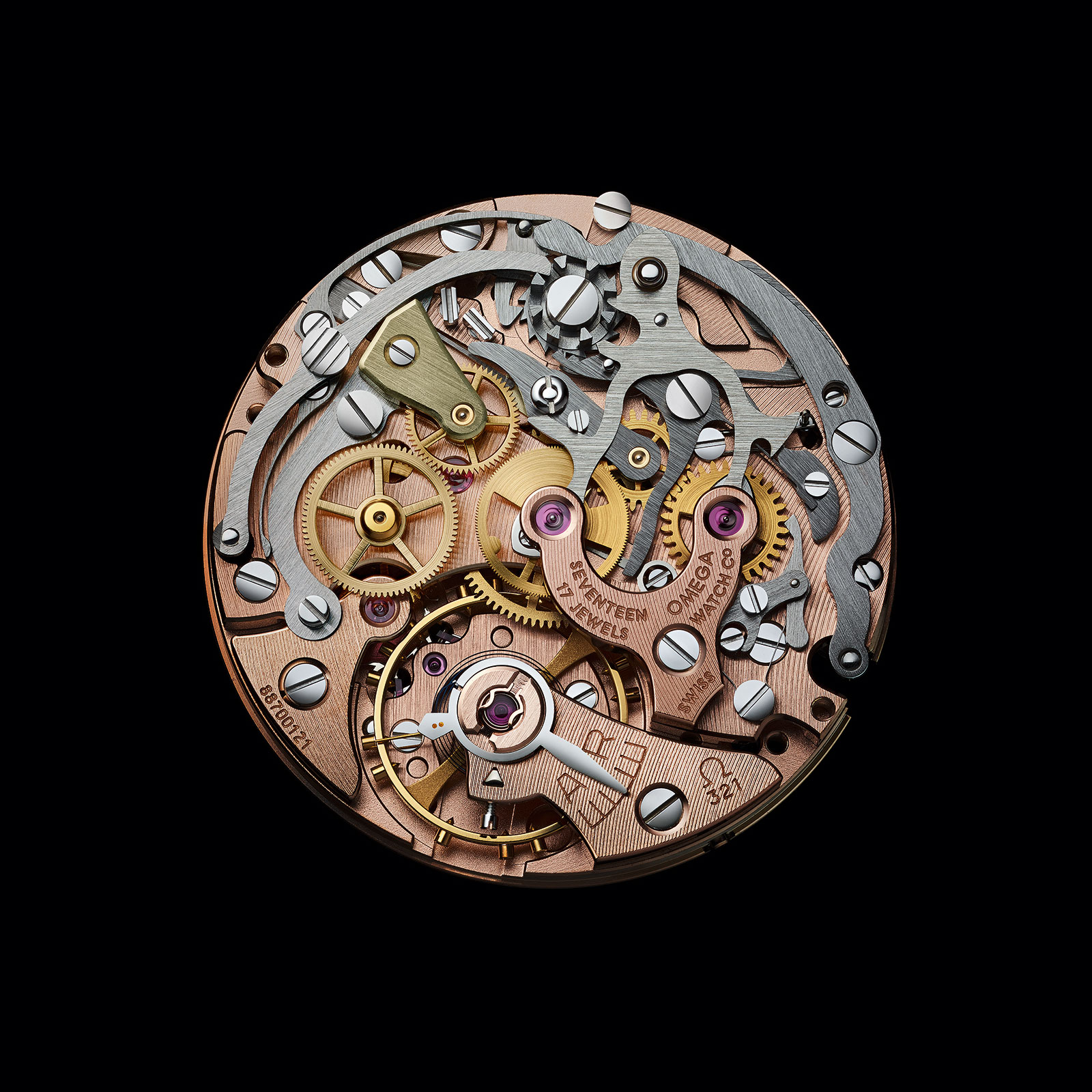
The modern-day Omega cal. 321 chronograph movement, featuring a regulator index on a scale marked “A” and “R”, short for avancé and retard, French for “advance” and “slow”. Photo – Omega
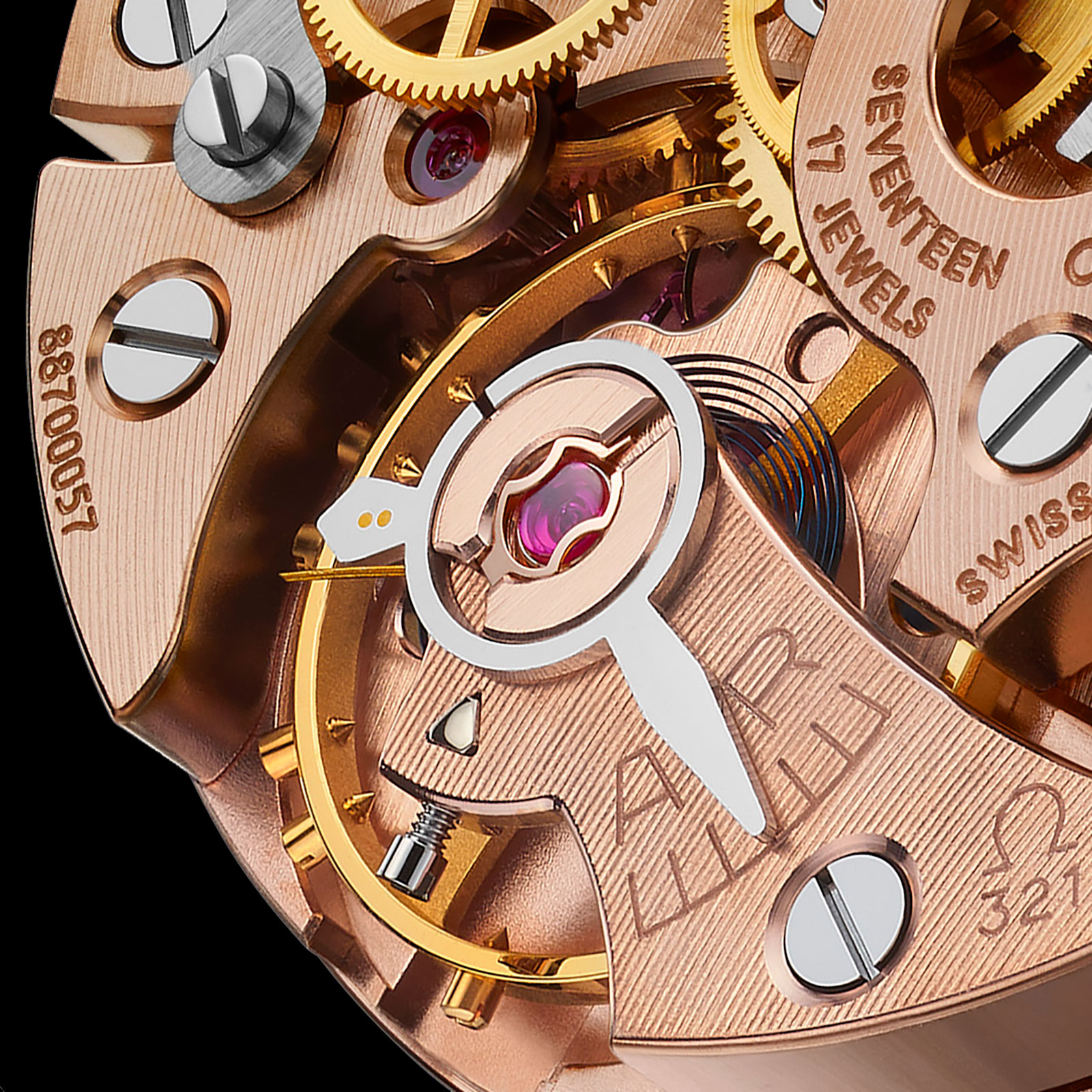
The two brass curb pins visible in the regulator index. Photo – Omega
These parallel pins are called curb pins and do not directly contact the hairspring, but allows the hairspring to “breathe” and bounce across each pin as it expands and contracts. The position of the curb pins determine the effective length of the hairspring – a shorter hairspring beats at a faster rate and vice versa.
The spacing between the pins must be carefully adjusted to be parallel, otherwise the watch will become susceptible to positional errors. Bent pins will result in varying interaction of the hairspring with the pins, for instance between the dial up and dial down position.
In contrast, the variable inertia balance, or adjustable mass balance, is the more sophisticated modern design and is typically found in higher end watches, with the best-known examples being the Rolex Microstella and Patek Philippe Gyromax. Nevertheless, the technology is slowly trickling down to more affordable watches, including all of Tudor’s watches equipped with in-house movement (and as it happens, Tudor is a subsidiary of Rolex).
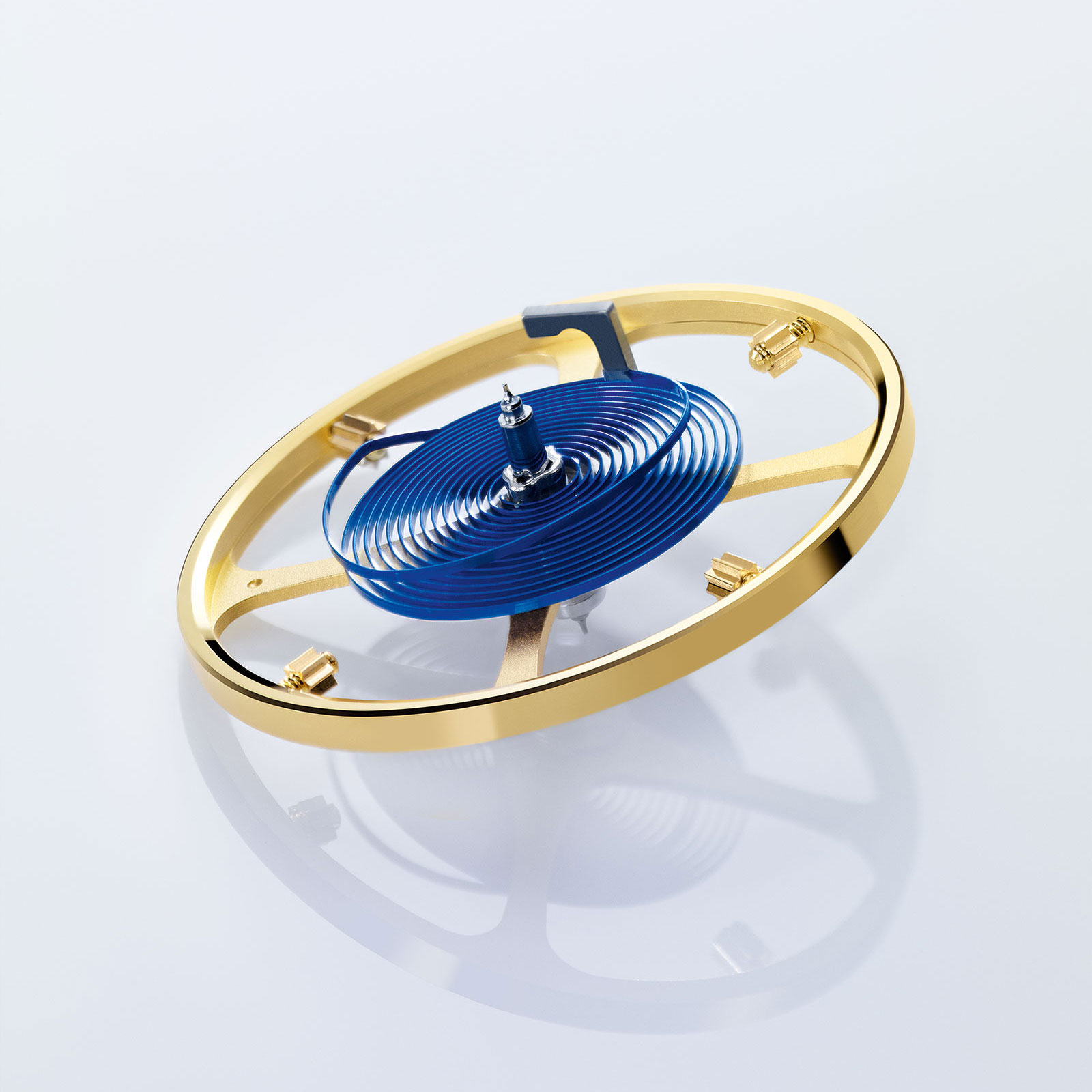
The Rolex Microstella. Photo – Rolex
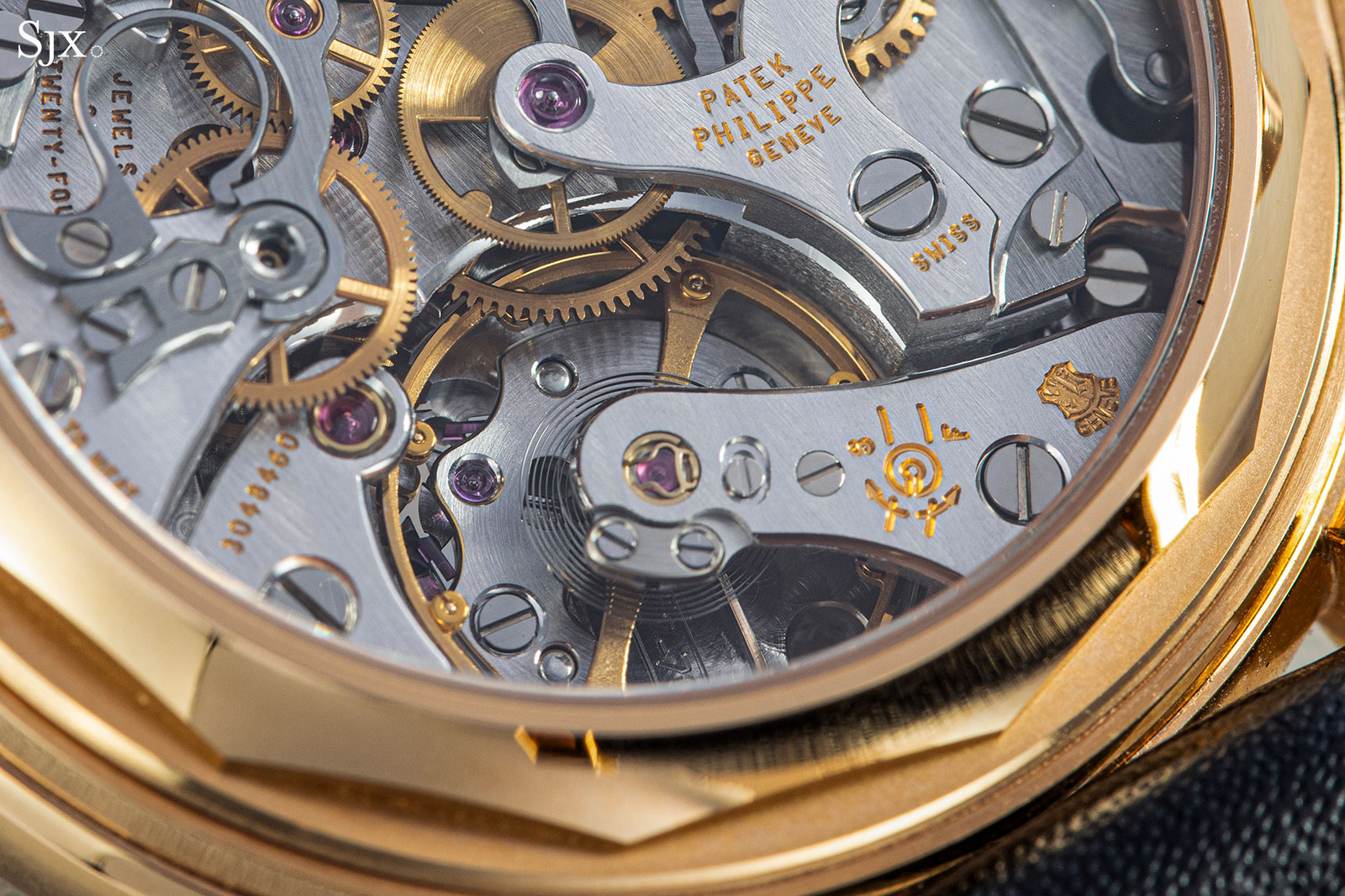
The Gyromax inside the Patek Philippe CH 27-70 Q movement, here in a ref. 3970
An adjustable mass balance has no regulator – instead, it relies on weights or screws attached to the balance rim for regulation. The small screws or weights are rotated to fine tune the rate of the watch – shifting the weights outwards increases the balance’s inertia which slows down the watch, and vice versa. A common analogy is an ice skater will spin slower with arms spread out, due to increased rotational inertia.
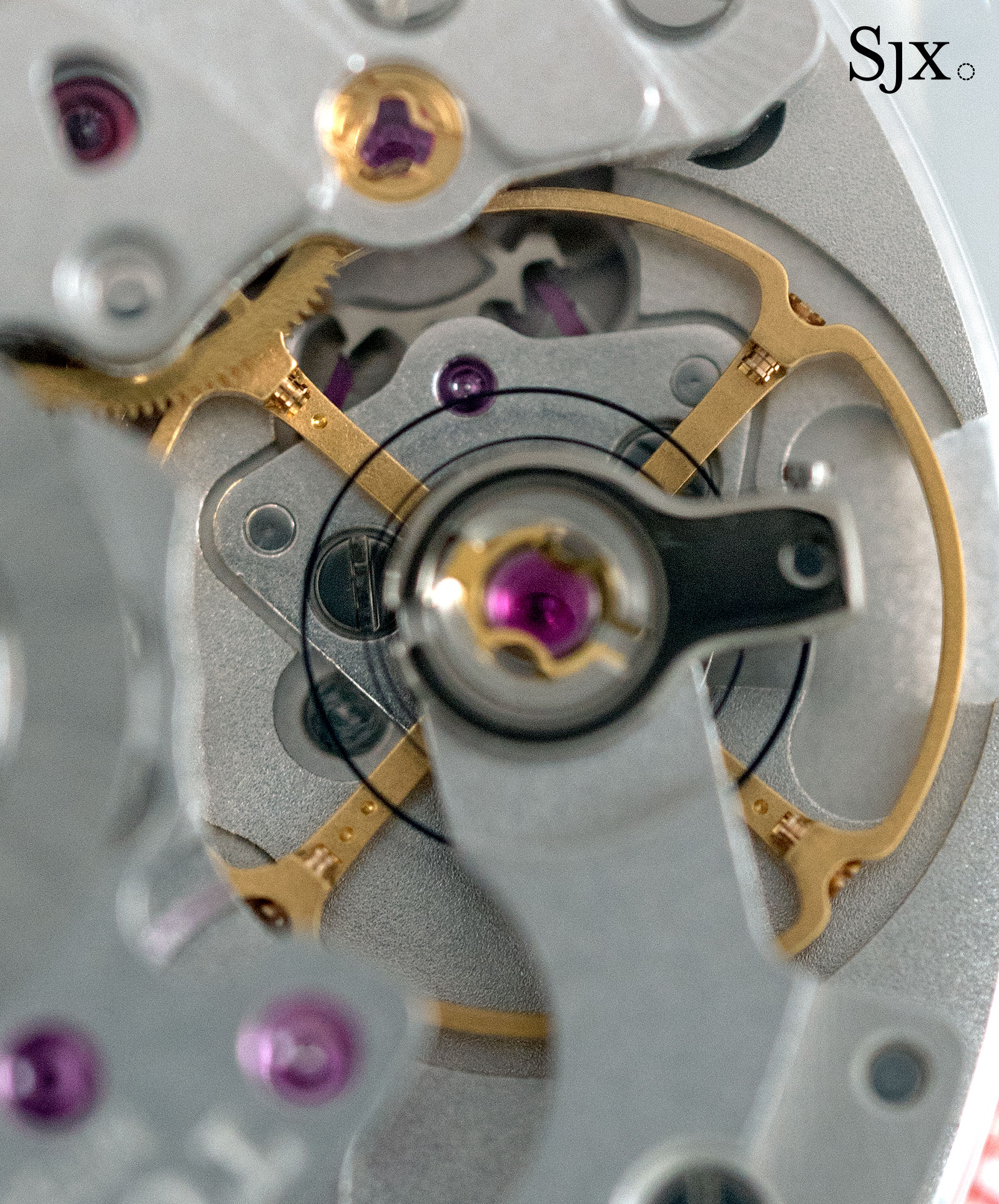
The adjustable mass balance in the Tudor MT5813 chronograph movement, which is derived from the Breitling 01
Since they do not have regulator pins and the hairspring breathes freely, they are also called free-sprung balances. In theory, these are less susceptible to positional error over regulator watches because the hairspring will not be susceptible to colliding with the regulator pins due to gravity. However, in practice a well-adjusted regulator balance would perform as well as a variable inertia one.
Upward progress
Watches don’t keep good time by accident. Much care is put into ensuring the precision stays consistent. Over time, this accuracy will deteriorate and thus the watch will require servicing to maintain its timekeeping and longevity.
But the fact that watches are put through daily use, and sometimes abuse, yet still manage to keep remarkably good time while relying on engineering of such a minute nature is a marvel. Though the basic concepts are centuries old, the technology is still progressing, albeit gradually, with better manufacturing methods and use of modern materials such as silicon.
Back to top.


